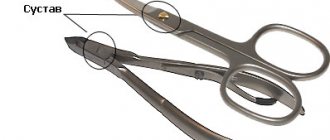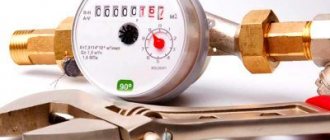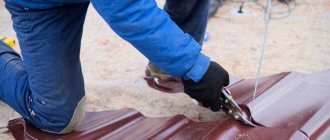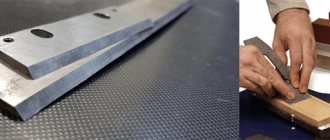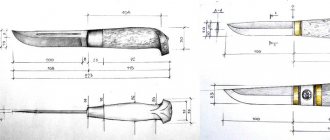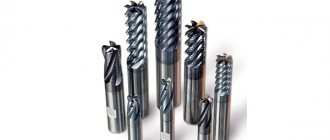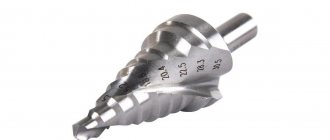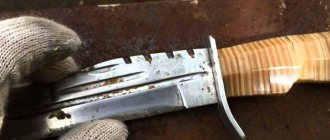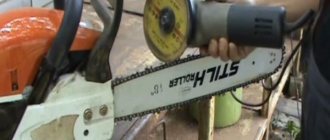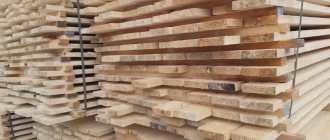Features of hairdressing scissors
Hairdressing devices, compared to conventional ones, are distinguished by the presence of sharp tips for high-quality grip of hair. They also have high quality steel and sharpening angle. There are 2 types of tools: straight and thinning.
Straight ones are used for cutting hair, beards, and mustaches. You can use thinning techniques with them. Special thinning tools are used to reduce the volume of curls, thin out the ends, and better shape the haircut.
Procedure
To sharpen hair cutting scissors with a file, it is necessary to carry out preparation and accurately follow the sequence of actions. A professional tool can easily be damaged, which is why you need to familiarize yourself with the features of this process in advance.
Preparation
Before carrying out work, you need to wipe the blades with a cotton pad soaked in alcohol. It is necessary to clean them of debris, hair residues, and dirt.
Sharpening hairdressing scissors
Step-by-step instructions for turning scissors at home:
- Hold the rings with your fingers so that the factory sharpening angle is fixed. Open the ends as much as possible.
- Sharpen the inside of the blades, keeping the angle to 70 degrees.
- Perform movements only in one direction, without longitudinal movements.
After carrying out the work, it is necessary to check the degree of sharpening of the thinning scissors. To do this, you need to try cutting the polyethylene oilcloth. If no problems arise, you can continue to use the tool.
Technology
Professional hairdresser scissors are an expensive device that requires special skills to sharpen. It has many types. A tool for sharpening hairdressing scissors allows you to improve the performance of various professional elements: nail scissors, drills, scalpels, knives.
During work, a minimal layer of metal is removed. Therefore, numerous resharpenings will be harmless to the device. After the procedure, the clippers can be used for 150 manicures. Store ones require updating after 10 clients.
The cutting part of drills and scissors can be flat, convex, or concave. For example, thinning tools are sharpened only on one side, and a slicing device is not sharpened, but polished with a disc. Hot scissors are sharpened by applying electric current to them.
Sharpening scissors using an emery stone
As mentioned above, the stone should be fine-grained. The second condition is that you need to sharpen the entire plane of the edge at the same time. The blade of the scissors should lie as shown in the photo. The entire plane and at the same time at an angle specified when the blade was stamped at the factory. Movement of the blade along the stone - along the blade, from the screw to the tip of the scissors. Well, the third condition is that you must have a “steady” hand. The angle of the blade cannot be changed when sharpening. Now be patient and sharpen, periodically removing any burrs that form on the inside of the blade by lightly moving the inside of the blade along the stone. Depending on the force applied to the blade and the quality of the emery wheel, in half an hour or an hour you will achieve that the scissors will cut perfectly. Attention! Be careful to protect your hands with leather gloves and do not allow children to sharpen scissors.
Device device
The machine for sharpening hairdressing scissors is presented in the form of an electric motor with a shaft on which there is a faceplate and a sharpening disk. There are 2 types of tools: with a horizontal faceplate and a vertical one. The former are best used for surgical, hairdressing, and manicure devices.
Technological machines have a laser “sight” and a manipulator that allows you to set the sharpening angle of the drills. Even a beginner can work with such a device. It is possible to select the speed of the disk movement based on the specific type of device. Thanks to the protective visor, harmful dust will not fly away in all directions.
Production and price
High-quality equipment is created in Germany and the USA. It's expensive. The most affordable device without a manipulator costs about 45 thousand rubles. The peculiarity of the equipment is its high mechanical requirements. There is no runout of the spindle on which the faceplate is located.
It is important that the abrasive surface moves perfectly, otherwise the required precision will not be achieved. The runout rates are indicated in the passport and are equal to no more than 0.11 s. In the workshop, the machine operates throughout the day, so the accuracy of the faceplate rotation determines the speed and quality of work. A reliable device operates for a long period without wear of mechanisms and bearings. Sharpening hairdressing scissors with it is performed at the highest level.
Characteristics
Machines for sharpening scissors and hairdressing tools have the following characteristics:
- Parameters: desktop equipment.
- Reverse: option for finishing tools.
- Disc parameters: 150-240 mm.
- Speed setting up to 3000 rpm.
- Electric motor: power is no more than 300 W.
- Weight: 30 kg.
The kit consists of additional abrasive discs, a wheel and polishing paste. The legs have rubber pads that dampen vibration.
Sharpening features
To sharpen professional hairdressing scissors correctly, you must use the following recommendations:
- Before use, the blades must be cleaned of accumulated dirt. To do this, use cotton wool or a cloth that is soaked in a solvent. After cleaning, the blade will be sharper.
- For the main procedure, use a file or a coarse-grained block. The result is then secured using coarse and fine sandpaper.
- Finally, you need to tighten the bolt connecting the blades.
With proper work and care, the devices will last for many years.
How to keep your instrument sharp at home?
Over time, many experienced hairdressers have come up with a number of tips for beginners that will help keep professional tools sharp for a long time. Recommendations:
- The opinion that it is necessary to boil scissors after cutting is wrong. Heat treatment with water has a negative effect on metal. The material begins to rust. To disinfect metal, you need to use special antiseptic solutions that are sold in pharmacies.
- It is advisable not to disassemble professional tools.
- Lubricate moving parts with oil once every six months. Thanks to lubrication, the opening mechanism is protected from corrosion.
- The main condition for successful turning is maintaining the factory angle. If it is changed, the instrument will be irrevocably damaged. Angles may vary depending on the purpose of the device.
- After each cutting, check the cutting edges. If burrs or irregularities appear, correct them with fine-grain sandpaper.
- Perform movements during turning only from yourself. You cannot move the blade back and forth. This will lead to even more blunting of the tool.
- After completing the work, check the degree of sharpening. To do this, you need to cut the fabric or polyethylene. If no effort is required, the tool can be used for cutting.
There are situations when a tool cuts poorly not because of poor sharpening. A common problem is the screw between two parts becoming loose. If the fastener is loose, the blades will “chew” the material. To correct the situation, you need to lubricate the screw with oil (vegetable, motor oil) and tighten it with a screwdriver.
Anyone can sharpen hairdressing scissors. To do this, just select one of the presented methods and perform the work in a certain sequence.
Choice
To sharpen hairdressing scissors efficiently, you need to choose a high-quality device. This takes into account the scale of work:
- For sharpening cutters and scissors.
- For processing manicure and hairdressing equipment.
- A multifunctional device that allows you to edit manicure hairdressing tools and drills.
- For straightening hair clippers.
All specified equipment is considered professional. It is suitable for sharpening drills, tailor's scissors, tweezers, meat grinder knives, cosmetic needles, dental devices, knives. It should be taken into account that abrasive wheels from the manufacturer of the device should be on sale.
How do you know when it's time to sharpen your scissors?
Yes, this is a very important point - because scissors really need to be sharpened not only correctly, but also on time. This will be better for your clients too - dull scissors begin to chop and break hair rather than cut it. The result, of course, is frayed ends that tend to split in just a couple of weeks. This will be better for your scissors too - because in advanced cases, scissors that have not been sharpened for a long time, again, deteriorate irrevocably.
We even published a special guide on how to carefully and accurately check the sharpness of scissors.
In general, how often you will have to sharpen your scissors, of course, largely depends on how high-quality the scissors are in principle. How hard their steel is and how skillfully the first sharpening is done.
At Mustang, we pay a lot of attention to ensuring that our scissors last a long time on one sharpening - this saves your nerves, money and time, and allows the scissors themselves to serve for a long time. Admire the models in our catalog and see which one is best for you:
Professional work
Professional sharpening of hairdressing scissors will be the best option, since the master will do everything efficiently. Since the devices differ in design and purpose, different types of sharpening can be used:
- Standard.
- Slicing.
- Pointing.
- Semi-convex.
- Convex.
If you do not have the skills to work with a sharpening tool, then it is better to give the scissors to a specialist. After this, the hairdressing device can be used for a long time.
Cutting edges of scissors blades
Any scissors cut fabric with the edges of the blades indicated by the arrow. The angle of these edges may vary depending on their purpose. These scissors in the photo are intended for office work, and therefore the angle is almost 90 degrees. However, sharp and serviceable scissors should also cut fabric.
But in this case, they do not cut the fabric at all, but only squeeze it between the blades. By the way, tailor's scissors need to be checked on the thinnest fabrics, such as chiffon or silk. If scissors cut such fabric, not only with the blade, but also with their tips, then they are perfectly sharpened.
Why don’t these scissors, which look quite sharp, cut fabric? There may be several reasons, the simplest of which is that the fastening of the blades has become loose. The gap between the cutting edges has increased, and the thin fabric is simply pinched, but not cut. Let's try to tighten the screw connecting the blades and try to cut the fabric.
Quality checking
After sharpening, you need to evaluate the type of tool. It is important to pay attention to how the canvases adhere to each other. It is necessary to check the movement of the devices. It is lightweight, no snagging or jerking. If this is so, then the work will be high quality and accurate.
Since hairdressing scissors are used for cutting hair, you need to check the quality of sharpening using a suitable method. For example, on your own hair or artificial hair. A piece of cotton wool is used for testing. The result will be noticeable on the cut. A well-processed device will last for many years, pleasing you with the results of its work.
